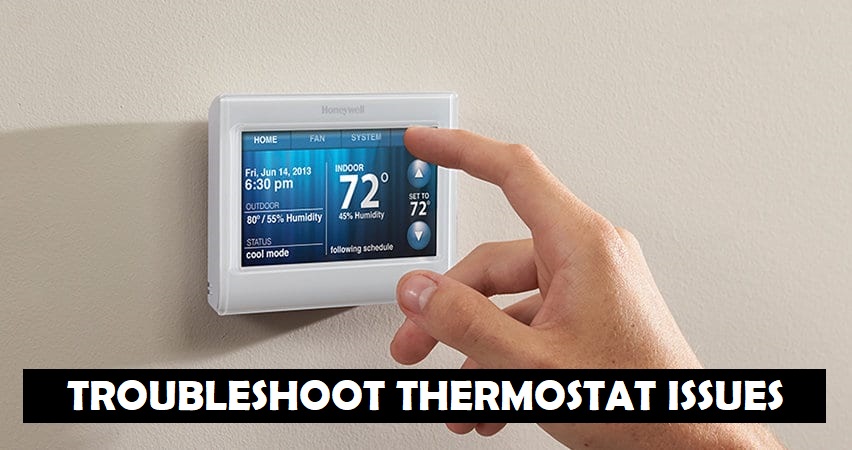Your thermostat, often taken for granted, serves as the control center for your home’s heating and cooling system. It’s responsible for ensuring your indoor environment remains comfortable year-round. However, like any other piece of technology, thermostats can encounter problems from time to time. In this comprehensive guide, we will delve into the intricate world of thermostat troubleshooting, helping you understand the issues that can arise and equipping you with the knowledge to resolve them efficiently.

Understanding the Basics
Before we embark on our troubleshooting journey, it’s crucial to have a fundamental understanding of how thermostats operate. This knowledge will serve as the foundation for our problem-solving efforts.
What is a Thermostat?
A thermostat is a small yet highly significant device that regulates the temperature in your home by controlling your heating and cooling systems. Its primary purpose is to maintain your desired indoor temperature by turning these systems on and off as needed.
Types of Thermostats
Thermostats come in various types, including manual, programmable, and smart thermostats. Each type offers distinct features and functionality, and consequently, they come with their unique troubleshooting methods.
Common Thermostat Problems
Now that we’ve covered the basics let’s move on to the most frequent thermostat issues homeowners encounter.
Thermostat Not Responding
One of the most frustrating situations is when your thermostat appears unresponsive to your temperature settings. Here’s how to troubleshoot it effectively.
1. Check the Power Source
First and foremost, you should ensure that your thermostat has a reliable power source. For battery-operated thermostats, replace the batteries if they are low or dead. If your thermostat is wired, inspect the wiring for loose connections or damage.
2. Calibration Issues
Calibration problems can cause your thermostat to display inaccurate temperatures. To recalibrate it, follow the manufacturer’s instructions carefully. Typically, this involves adjusting the thermostat’s settings to match a known, accurate temperature source.
Uneven Heating or Cooling
Another common issue is uneven temperature distribution throughout your home. This problem may not necessarily be linked directly to your thermostat, but it’s important to rule out thermostat-related causes.
1. Check Air Vents
Blocked or closed air vents can disrupt the airflow from your HVAC system, leading to uneven temperatures. Ensure that all vents are open and unobstructed to allow for proper circulation.
2. Inspect Insulation
Poor insulation in certain areas of your home can also contribute to uneven temperatures. Inspect the insulation in your attic, walls, and windows, and address any deficiencies you find.
Thermostat Wiring Problems
Wiring problems can be a bit more complex to troubleshoot, but they are not uncommon.
Faulty Wiring
Issues with thermostat wiring can lead to malfunctioning or unresponsive thermostats. To address this problem, follow these steps:
- Turn Off Power: Before touching any wires, turn off the power to your HVAC system at the circuit breaker.
- Inspect Wiring: Carefully examine the thermostat wiring. Look for loose or disconnected wires.
- Reconnect or Replace: If you find any loose wires, gently reconnect them. In the case of damaged wires, it’s best to replace them. Always refer to your thermostat’s manual for proper wire placement.
Color Code Identification
Understanding the color code for thermostat wires is essential when diagnosing wiring problems. Here’s a quick reference for common wire colors:
- R (Red): Power wire
- W (White): Heat wire
- Y (Yellow): Cooling wire
- G (Green): Fan wire
- C (Blue): Common wire (used in some systems)
Smart Thermostat Troubleshooting
With the advent of smart home technology, many homeowners have switched to smart thermostats. These devices offer advanced features but can also encounter unique issues.
Connectivity Issues
Smart thermostats rely on Wi-Fi connectivity to function properly. If you encounter connectivity problems, follow these steps to troubleshoot:
Reset the Wi-Fi Connection
Sometimes, simply resetting the Wi-Fi connection can resolve connectivity issues. Refer to your thermostat’s manual for instructions on how to do this.
Firmware Updates
Outdated firmware can lead to various problems with your smart thermostat’s performance. Manufacturers often release firmware updates to address known issues and improve functionality. Check your thermostat’s app or website for instructions on updating the firmware.
In conclusion, understanding how to troubleshoot thermostat issues is essential for maintaining a comfortable and energy-efficient home. Always start with the basics, such as checking the power source and calibration, before delving into more complex issues like wiring problems. By following these steps and staying proactive, you can ensure that your thermostat continues to serve you effectively.




